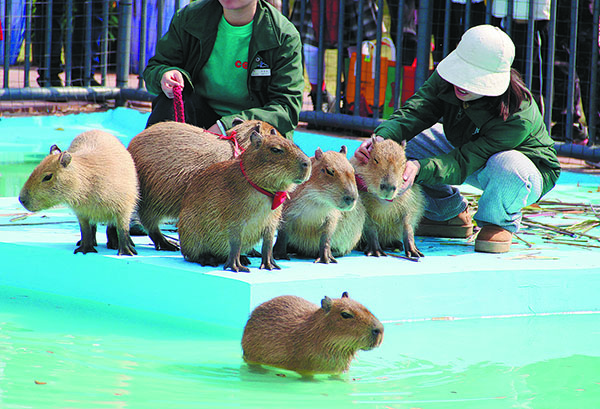
Workers at the Nanning Garden Expo Park in the Guangxi Zhuang autonomous region arrange red bow ties for the six capybaras during the Spring Festival holiday.
NANNING — The air crackled with excitement one sunny afternoon at the Nanning Garden Expo Park in the Guangxi Zhuang autonomous region. An eager crowd gathered around a semiaquatic enclosure, entranced by its serene star residents.
"I finally got to see a capybara in person," says one 10-year-old visitor, clutching a plush capybara in one hand and attempting to take a photo of the real-life creature with the other. "They are the absolute cutest, especially in their Chinese New Year outfits!"
Large rodents indigenous to parts of South America, capybaras, which are affectionately called "Capy" by die-hard Chinese fans, have brownish-yellow fur and tiny triangle-shaped ears that look like little spread wings.
With half-lidded eyes, large heads and a barrel-shaped torso, they are often to be found sitting in a relaxed and Zen-like state, exuding an unusual sense of serenity and ease.
"The red bow tie is such a fun touch for Capy," says millennial Wang Zhirong, scrambling to take the perfect shot of one of the animals in their festive red. "There's something fascinating about the playful contrast between their stylish outfits and their laid-back demeanor. It's giving me great ideas for my special Chinese New Year emojis."
But it's not just affable looks that have propelled capybaras to stardom in China. The name of these creatures itself has a certain charm as it rolls off the tongue.
"The cuteness of their name gives the capybara a universal appeal that transcends language barriers," says Li Xin, an English teacher at a local middle school. "I have even chosen some online articles about them for my students to enjoy as light reading."
"On a deeper level, the fanfare boils down to the fact that they epitomize something we all strive for in life — a laid-back approach to whatever the future holds," Li adds.
In the past year, the capybara phenomenon has surged in China, with the animals building a large following on social media.
A search on the Chinese lifestyle app Rednote easily yields over 1.19 million posts, while capybara tagged videos on short-video sharing platform Douyin have amassed 8.12 billion views.
The internet sensations have also spawned a dazzling array of merchandise, from cuddly stuffed animals to mobile games.
Last October, the Nanning Garden Expo Park welcomed six of the rodents. To help the cuddly giants adapt to their new urban life, a specially designed environment was created that closely mimics their natural habitat, complete with greenery and a pool area.
"Capybaras thrive in a semiaquatic setting," says Liang Qiuyi, an animal breeder at the park. "They spend a significant amount of time in the water to regulate their body temperature and avoid bothersome insects."
Like many other mammals, capybaras communicate their needs and emotional state through vocalization. This form of communication provides valuable insight for their caretakers.
"Listen closely, and you'll find that a series of squeaks usually means they are hungry. A rhythmic, low sound, similar to the short bursts of a machine gun, typically indicates that they are relaxed and comfortable. When they're alert, or warning their companions of potential danger, they emit sharp, birdlike chirps."
Li says that visitors are only allowed to interact with the six capybaras in the park in specially designated areas.
"Contrary to common belief, increasing the park's popularity is not our primary goal in acquiring these lovely animals," Liang says. "For us, the bigger picture is to bring the younger generation closer to nature and spark a passion for wildlife, especially through the growing affection for capybaras."
To this end, the park has started a wildlife-themed science outreach program, complemented by a list of extracurricular activities designed specifically for capybara enthusiasts, in the hopes of fostering a deeper understanding of wildlife protection, and inspiring people to contribute to conservation efforts.